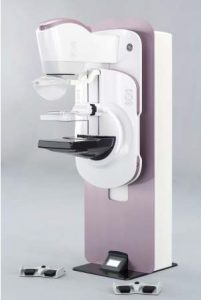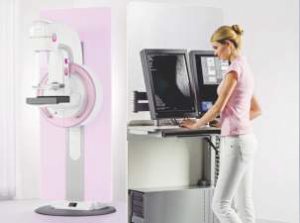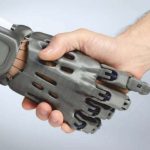GE Healthcare recently received FDA clearance for ‘Senographe Pristina Dueta’ that allows women undergoing an exam to control the rate of compression
GE Healthcare won FDA clearance for the first mammography system, the Senographe Pristina Dueta, that lets women undergoing an exam to control how much the device compresses the breasts. As the woman is prepared for the exam, she is handed a small remote control that has a plus and minus buttons on it. The breast is then positioned by the technologist between the compression plates and from then on the patient has control in terms of how much compression she’s willing to take, Medgadget reported recently.
While compression is still necessary to achieve proper imaging, patients that have undergone examination using the Senographe Pristina Dueta report a more comfortable experience and the clinicians noted considerably more relaxed patients. Reduced stress in the examination room can help lead to better images, as the patient cooperates better and moves less. This can therefore lead to earlier detection of cancer, earlier treatment, and improved final outcomes.
patients. Reduced stress in the examination room can help lead to better images, as the patient cooperates better and moves less. This can therefore lead to earlier detection of cancer, earlier treatment, and improved final outcomes.
GE Healthcare hopes that by improving the experience more women will be interested in regular mammography screenings, improving the overall rate of treatment and lowering the burden of breast cancer.
“This is a new age in breast imaging,” said Dr. Kathy Schilling, Medical Director of Christine E. Lynn Women’s Health & Wellness Center at the Boca Raton Regional Hospital.
“Patients who used the remote control said the exam was more comfortable and they were visibly more relaxed. Any breast radiologist knows that when patients are relaxed, we are able to get better images and better images lead to a more confident diagnosis,” the radiologist who conducted a clinical review of the new device said.
”My hope is that increasing comfort during the exam and giving patients the option of working with the technologist to set their own compression will increase compliance, enable early detection and improve outcomes,” he added.
The best chance of early detection of breast cancer is a mammogram. Evidence shows that finding breast cancer early reduces a woman’s risk of dying from the disease by 25 to 30 per cent or more. But for many women, the number one reason they don´t schedule a mammogram is because of the fear and anxiety from the potential result and exam discomfort. That’s why a team of female engineers and designers in Paris came together to design the new mammography technology.
Inside GE Healthcare’s imaging technology center in the town of Buc, located just outside of Paris, Industrial Designer Aurelie Boudier brought a team of women together to bring their unique insights as patients to answer one question: how do we design a more comfortable mammogram? Their vision would eventually turn into a new mammography system unlike any others, one designed specifically with comfort in mind.
“My challenge was how to totally change the perception of mammography, especially for the patient, and increase compliance,” Boudier says.
The result is a completely redesigned mammography system, Senographe Pristina,that now features an option to use a first-in-industry patient-assisted compression remote control to enable the patient, with the help of a technologist, to set the compression that feels right for her.
The handheld wireless remote control, called Pristina Dueta, allows patients to adjust the compression force after breast positioning. The technologist then guides the patient while she operates the remote control to adjust compression until she reaches an adequate compression level.
“The design strives to minimize women’s perceived pain and discomfort by giving them an active role in the application of compression,” Boudier says.
In a patient satisfaction study conducted with 160 patients in two sites in Europe, when a patient experienced a Senographe Pristina exam coupled with Pristina Dueta, 79 per cent of the patients who used the patient-assisted compression device found it improved the comfort of their exam, and 54 per cent found it led to less anxiety.
Design for Comfort
The system features other design enhancements to make the exam more comfortable.
“We know that compression can be painful,” Boudier says. “Senographe Pristina is more comfortable and the design helps improve patient comfort during screening. Because the imaging detector is thinner with rounded corners, patients say that it’s more comfortable because there’s less coming in contact with their bare skin.”
The system’s design also changes the way a patient is positioned. Instead of women projecting their stress on handles by grabbing them too firmly, which tenses pectoral muscles and has an impact on image quality, they can lean comfortably on the armrests, relaxing the muscles to simplify positioning, compression and image acquisition.
When the patient is more relaxed, technologists can focus on precise positioning, potentially making the exam easier and faster. This reconsidered philosophy of patient positioning is a totally different approach, according to Boudier. These new compression techniques and positioning options are a powerful combination in terms of patient perception and patient comfort.
Feedback
With empathy at the center of this product, part of the design process was working closely with patients,  technologists and radiologists from Gustave Roussy Cancer Center in Paris, one of the largest cancer treatment centers in Europe. These key stakeholders gave GE Healthcare critical input to ensure the system addressed clinicians’ and patients’ concerns.
technologists and radiologists from Gustave Roussy Cancer Center in Paris, one of the largest cancer treatment centers in Europe. These key stakeholders gave GE Healthcare critical input to ensure the system addressed clinicians’ and patients’ concerns.
Senographe Pristina also incorporates calming colors and smooth shapes again to help reduce patient anxiety and make the mammogram a more positive experience. Boudier says users are optimistic that the system will help inspire women to come back for screening every two years. “We’ve gotten very good feedback,” she says. “Physicians say patients are pleased with the machine.”
More than mammography
Senographe Pristina is part of GE Healthcare’s commitment to the SensorySuite, which simultaneously stimulates at least three of a woman’s senses – scent, sight and sound – and improves the experience globally in an immersive strategy to help reduce the perceived discomfort, pain and anxiety of a mammogram.
Boudier says this “innovative design approach” was a deliberate design choice. “We really considered not only clinicians, but every user – the technologist and the patient,” she says. “I know that our team did our job if more women are going for their annual mammograms and aren’t scared to walk into the room and do the exam. It’s such an important part of maintaining a healthy life and I want it to be a less painful experience for women around the world.”














